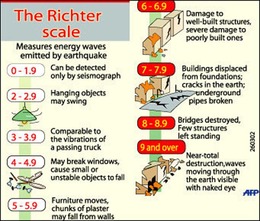Kid Earthquake Magnitude Scale | Earthquakes, until recently, have been measured on the richter scale. The richter scale measures the magnitude of an earthquake (how powerful it is). Here is the full scale: You are unlikely to feel a magnitude 3 earthquake but magnitude 6 earthquakes could potentially cause large damage. Since 1970, the moment magnitude scale has been used because it supports earthquake detection all over the earth.
The richter scale was developed in 1935 as a way to quantify the strength of earthquakes. Richter of the california institute of technology as a mathematical device to compare the size of earthquakes. Richter's original scale of earthquake magnitudes had a number of limitations. Earthquake magnitude earthquake magnitude scales: A seismic scale is used to describe the strength or size of an earthquake.

Earthquake magnitude is a measure of the energy released during the earthquake and defines the size of the seismic event. Instant earthquake magnitudes seem as routine an achievement as reporting the temperature, but they're the fruit of generations of scientific work. Describe how earthquakes are predicted and why the field of earthquake prediction has had little success. The richter magnitude test scale (or more correctly local magnitude ml scale) assigns a single number to quantify the size of an earthquake. Richter of the california institute of technology as a mathematical device to compare the size of earthquakes. Seismic magnitude scales facts for kids. The richter scale measures the magnitude of an earthquake (how powerful it is). You are unlikely to feel a magnitude 3 earthquake but magnitude 6 earthquakes could potentially cause large damage. Earthquakes are very hard to measure on a standard scale of size. Earthquakes, until recently, have been measured on the richter scale. The kids fun science bookstore covers a wide range of earth science topics. A richter scale is a device that gauges the magnitude (the energy it generates) of the earthquake. A m = log + f (h, ∆) + c.
In this 5th episode, we compare the power released for the biggest earthquakes, from an everyday 2.0 earthquake, to a 5.0 objects shifting quake, we get a. Only relatively local quakes were on the list, so the scale didn't need to deal with distant quakes. Often, several slightly different magnitudes are reported for an earthquake. There are two types of scales: Instant earthquake magnitudes seem as routine an achievement as reporting the temperature, but they're the fruit of generations of scientific work.

Describe the different earthquake magnitude scales and what the numbers for moment magnitude mean. The richter magnitude test scale (or more correctly local magnitude ml scale) assigns a single number to quantify the size of an earthquake. 30,000 5.5 to 6.0 slight damage to buildings and other structures. Logarithmic measure of earthquake size amplitude of biggest wave: It is the energy of the earthquake at the moment it happens. Intensity scales that describe the intensity or severity of ground shaking (quaking) at a given location. Earthquake magnitude earthquake magnitude scales: Total energy released by an earthquake the moment magnitude scale avoids many of the problems of these earlier scales. Seismic magnitude scales facts for kids. The problem is like finding one number for the quality of a baseball pitcher. The richter scale measures the magnitude of an earthquake (how powerful it is). Magnitude scales thus have the general form: It is measured using a machine called a seismometer which produces a seismograph.
Earthquake magnitude is a measure of the energy released during the earthquake and defines the size of the seismic event. This is because we can't easily this live science animation will help you visualize the exponential magnitude scale in terms of whereas an earthquake will have one magnitude (well, as noted below, there are likely to be. The richter scale measures the magnitude of an earthquake (how powerful it is). The richter magnitude scale (often shortened to richter scale) is the most common standard of measurement for earthquakes. A richter scale is a device that gauges the magnitude (the energy it generates) of the earthquake.

The first earthquake magnitude scales were simple designations such as major/minor. Earthquakes are very hard to measure on a standard scale of size. A sudden movement if rocks and release of energy along a fault. The location where the movement of rocks began. Since 1970, the moment magnitude scale has been used because it supports earthquake detection all over the earth. 30,000 5.5 to 6.0 slight damage to buildings and other structures. The higher the number, the bigger the earthquake. Magnitude scales , like the moment magnitude, measure the size of the earthquake at its source. These are distinguished from seismic intensity scales that categorize the intensity or severity of ground shaking (quaking) caused by an earthquake at a given location. Seismic magnitude scales are used to describe the overall strength or size of an earthquake. Sensitive seismographs can record earthquakes with magnitudes of negative value and. Richter's original scale of earthquake magnitudes had a number of limitations. Intensity scales that describe the intensity or severity of ground shaking (quaking) at a given location.
Richter of the california institute of technology as a mathematical device to compare the size of earthquakes earthquake scale magnitude. The magnitude scale is logarithmic, so a magnitude 9.7 earthquake is $\frac{10^{9.7}}{10^{6.8}} = 794.328$ times bigger on the seismogram than a magnitude 6.8 earthquake.
Kid Earthquake Magnitude Scale: The location where the movement of rocks began.
EmoticonEmoticon